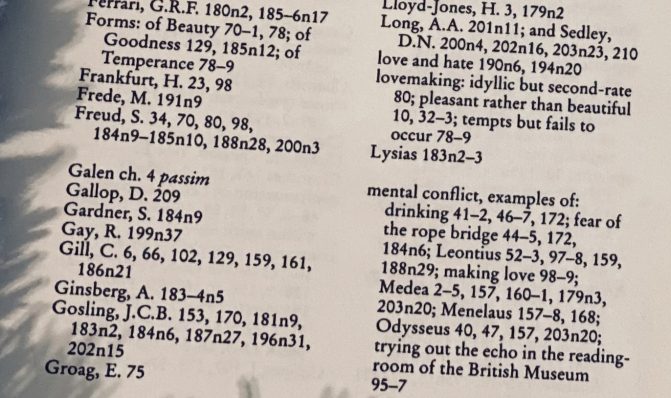DIY Indexing for Academic Authors | Lex Academic Blog

For a first-time indexer, the task of compiling what Isaac D’Israeli called ‘the nerves and arteries of a book’ can be daunting. This is, of course, why many authors use professional indexers like Lex Academic. But with the right guidance, creating your own index can be both enjoyable and rewarding.
Indexing is painstaking work that requires absolute concentration. So, set aside enough time to work calmly. Allow 10-15 hours per 100 typeset pages and remember that your brain needs time to rest. Rumination makes for a better index.
Next, establish the format. The publisher should provide style guidelines covering matters such as elision of page number ranges, run-on or set-out subentries, see also or see also preferences, and length (if unspecified, aim for about 5% of the number of typeset pages). Decide whether you need a separate index nominum (index of names) and index verborum (word index), whether a specialist index (of pharmaceutical terms or legal cases, say) is needed, and whether alphabetization will be word-by-word (Red Cross before Redcar) or letter-by-letter (vice versa). And be consistent thenceforward.
Now, read the book, closely and methodically, from page one. Although jotting down topics to look out for can be useful, don’t be tempted to list headwords and hit Ctrl-F for each one. Build the index by marking each term or name for inclusion. The aim is to produce not a concordance, but a treasure map to your book. The text-search approach, which may be tedious for the indexer, can also produce long strings of page numbers for the reader to labour through. The result? Frustration.
Which terms should be indexed? Herein lies the art of indexing. As with any art form (pace blog post 12-10-21), it is a mixture of skill and flair and must be carried out by a human. For a stark illustration of this, see Dennis Duncan’s book Index, A History of the. It has two indexes, one of which is made by AI software and the other by a professional.
The secret is to hold the user(s) – specialists, generalists, librarians, et al. – at the forefront of your mind. A good index is a work of imagination. The experienced indexer develops a sort of empathy with the book’s future readers – an educated feel, put simply, for what they will want to look up. The reader might, for example, use the index before or after reading the book. They may never even read the whole text, but only skim the portion relevant to their overdue research paper or essay.
As a reader and index user, the author will therefore have some feel for which terms to include and obviously has the most thorough knowledge of the book’s contents. But there is a sense in which it is possible to be too close to a text, which is the advantage to using an indexer who has the perspective of a reader. Professionals are also experienced at selecting those cross-references, subentries, and access points that will be most helpful to the end user.
Some guidelines: when listing entries, choose nouns or noun phrases. Adjectives are too subjective to be useful (cakes, best for parties, not best cakes for parties). However, make an exception for terms such as virtual reality (not reality, virtual). Choose the salient noun (blancmange, characteristics of, not the reverse). Unless they are proper nouns, entries should be lower case and identical to those in the text – including hyphenation. Only index author names where there is discussion of their work; don’t index citations.
It is important to include cross-references where there is a commonly used alternative, and critical to provide appropriate subentries for quick guidance. Only index substantive rather than tangential references. Do what AI can’t do and index concepts, even when the word is not specifically mentioned. If in doubt, include rather than exclude at this stage; removing headwords later is far easier than combing back through the text for omissions.
One invaluable piece of advice is to read other indexes, especially in your own field. You will encounter both the good and the faulty, and may find yourself harumphing occasionally. Like their creators, indexes have personality: they give a ‘glimpse of the book’s spirit’, as Harold Macmillan wrote on the founding of the Society of Indexers in 1957. Indexes are sets of choices and the results can be scrupulously neutral, strongly flavoured (Bonaparte, Napoleon, examples of his magnificence), or pedantic and pedestrian – bear this in mind. Incidentally, they can also be humorous (see Lewis Carroll’s Sylvie and Bruno or Alan Partridge’s memoirs) or carry a narrative, as in JG Ballard’s story The Index, itself written in the form of an index.
Once built, the index must be edited. Depending on page limit, it may be necessary to prune (more choices). The wording and spelling of entries must be checked alongside cross-references. Are there any issues with balance? You may have over-indexed certain sections. Also, look for blind alleys (see also entries leading nowhere).
It is good practice to print the index for a final check. Sit at a different desk, get the red pen out, and you will spot things you didn’t see on screen. There is a certain satisfaction in holding the finished creation in your hand. Finally, if you can find a willing volunteer, have someone test-drive your index for missing terms or other difficulties.
Indexing is hard, detailed work. But it can also be stimulating and rewarding, so enjoy the challenge!
Be notified each time we post a new blog article